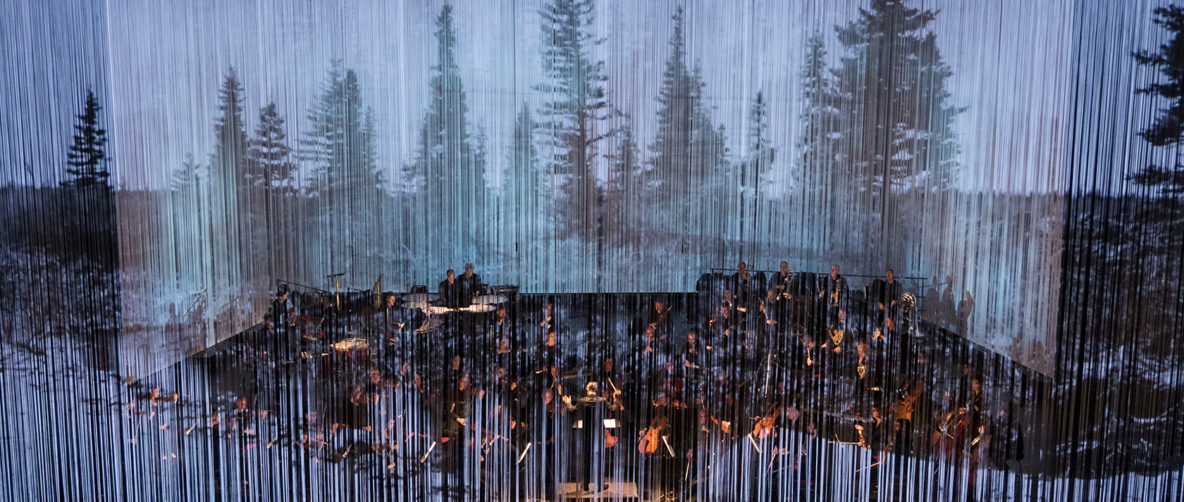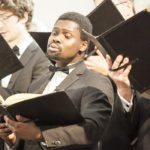Life Reflected– NAC orchestra + Normal studio
June 18th
Sony Center, Luminato festival.
This very ambitious project positions the orchestra in front of a large screen at the back of the hall, between two screens on each side of the orchestra and behind a fringed curtain that separates the ensemble from the public . All these surfaces are used for projections that create a dialog with the music and the text – when there is one – and with the music itself.
Even if the figure of the woman is central to the project, there is no narrative built throughout the concert. Each piece is an expression of that theme and the order of the pieces makes it for the most part a unified and coherent journey.
Four famous Canadian women (Alice Munro, Amanda Todd, Roberta Bondar and Rita Joe) inspired music composed by 3 Canadian women composers: Zosha di Castri, Jocelyn Morlock and Nicole Lizée. John Estacio wrote the final piece of the program and is the only male composer on the program.
This project is very Canadian as it strives for equal gender representation, a sense of reparation with the First Nations and an Ad mare usque ad mare intention. This usually annoys me as it is more often political or self-righteous but here, the artistic content and the purity of the intentions make this concert a very genuine one.
Dear Life, the first piece by Zosha di Castri and the narrative of Nobel prize winner Alice Munro’s short novel is by far the most dramatic and challenging of the four sections and is closest to what is “traditional” contemporary music. The music is the most dissonant, conceptual and explorative and accompanies well the dark rural, small town spirit and suffering that the text displays. I’m used to new music so this was not too much of an ear challenge to me, but it might be the harshest bit of music for a neophyte. In the scope of the longer curve of the concert, it is well paced, as the other pieces feel like a reprieve. I especially liked how Di Castri wrote for the orchestra when it blends into the bird sounds. The videos are narrative and support the psychological density expressed in the music and the text.
The second piece, My Name is Amanda Todd, by Jocelyn Morlock, was the most poignant. I played music by Jocelyn in 2011-Birds in a Tangled Sky for clarinet, violin, cello and piano- in our show “The Birds” that toured Canada and France. It was a great occasion to hear her music again and to see how her music making has evolved in time. My Name is Amanda Todd is an elegy over the death of Amanda Todd who committed suicide after sustained episodes of cyber-bullying. I never know for sure what a composer’s intentions are, but the powerful, yet light and vibrant music of Jocelyn made me think that Amanda was living now through the music. I felt that her regained freedom, the freedom of young women experiencing life was best now lived in music and with us. It was a pretty transcending experience for me: the music made me feel and share what seems to be the prolongation of her life through music. A sense of intimacy and sustained joy balanced the terrible reality she had to suffer. The videos by Normal studio were very playful and in sync with the musical purpose, enhancing this feeling of freedom and joy. It was a really powerful moment for me and as I write these lines I still feel what the experience brought me. This was my high point for the concert.
The third piece by Nicole Lizée, Bondarsphere, features the first Canadian female astronomer to be in space, Roberta Bondar. In terms of overall prowess and coherence between video projection, lighting and music, this is the high point of the concert. All components are interrelated to create a form of art that is hybrid. It doesn’t feel that one accompanies the other, or commenting or meeting in a point and going apart after a while. I think that Nicole’s involvement in the making and conception of the video made a capital difference.
The last piece of the program, I Lost my Talk, inspired by Rita Joe and aboriginal culture was composed by John Estacio. It is the only piece that was not prompted by the project. It is a good choice at the end of the program as the music is really lofty and closes the journey in a flowing and accessible manner. I was not convinced by the choice of videos displaying aboriginal dances: I don’t think it brought the music or the stage presence of Rita Joe to another level.
Alexander Shelley’s conducting is beautiful. As a fellow colleague, I was impressed and marvelled (and envious!) by his technique and its overall effect on the orchestra. Fantastic and elegant left hand. His kind of conducting is the essence of coordination: it doesn’t mean to be able to do pirouettes and cerebral subdivision. It means that he is able to inhabit and display the multiple tensions, contradictions, shades and nuances in the music, in different areas of the body and in the body as a whole at the same time. His body is the theater of the music,
Bravo to the NAC to dare, imagine and invest!



